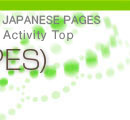
•Year started : 2008
•Actor : Tochigi Prefecture
In Tochigi Prefecture, forests, which cover 55 percent of the land, have played an essential role in citizens'lives. They have not only provided ecosystem services, including timber production and water recharge, but have also been enjoyed by many people as places for recreation and rest. However, during the period of economic growth and the bubble economy, residential land and recreation facilities were developed, consequently depleting forest area, while competition with inexpensive imported timber shrank demand for domestic timber and lowered wood prices. Therefore, domestic forestry and the lumber industry became stagnant, thereby hindering the proper management of these forests.
It should be noted that approximately 60 percent of the forest area in the prefecture is privately owned or communal, nearly 100 thousand hectares -approximately 30 percent of total forest area - of which were covered by Japanese cedar and hinoki cypress forests of the stand age of 16 to 60 years, therefore in need of thinning, at the end of fiscal 2008. Approximately 70 thousand hectares of these forests are aged 36 to 60 years, suitable mainly as construction wood. However, almost have of them have remained inadequately managed as a result of slumping lumber prices (log price for cypress produced in Tochigi marked 12,700 yen per spuare meter in fiscal 2008 (Tochigi, 2009)) which have dropped to one-third of what they were thirty years ago.
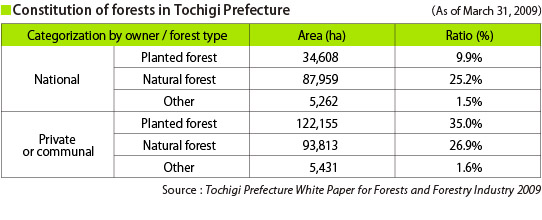
Tochigi Prefecture introduced the "Tochigi Prefectural Tax for Healthy Forest-Making" in April, 2008 with the aim of protecting and saving healthy forests for the next generation.

Nearly 80 percent of tax revenue is used for hard projects ( "Improving Healthy Forests" program), or direct forest improvement projects, including tree thinning in planted forests that have been left unmanaged for over 15 years and are no longer profitable, improving wooded areas in Satoyama for which there are local calls for conservation, and implementing measures to mitigate damage caused by wild animals. Soft projects ( "Fostering Forest Supporters" program), including environment education and communication to enhance understanding for the importance of forests are implemented; they include the provision of desks, chairs and benches made from forest thinning to schools and other public facilities in order to familiarize more people with the excellence of wood.
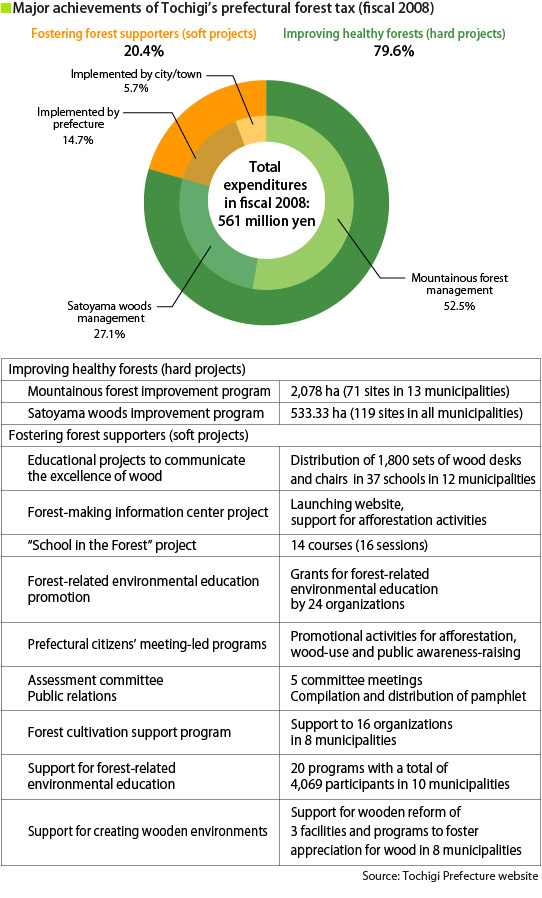
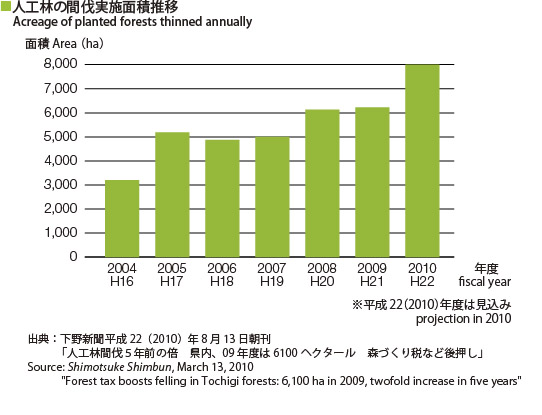
Every year, the "Assessment Committee for Tochigi Prefectural Tax for Healthy Forest Making" evaluates the effectiveness, efficiency and progress of each program funded by the tax revenue and discloses the outcome in September.
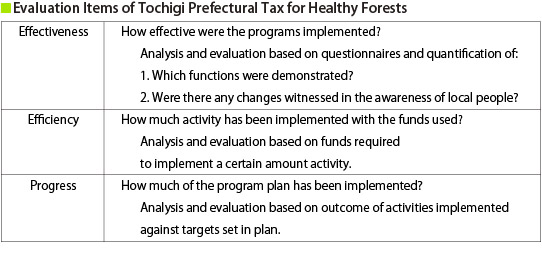
For example, the Assessment Report for fiscal 2008, evaluates the effectiveness of the
Mountainous Forest Improvement program funded by tax revenue by comparing the actual
expenditures (181 thousand yen per hectare) with the averted costs, or the assessed
economic value of the projects that might have been implemented (1.53 million yen per
hectare) in order to achieve the same effects, based on valuations of flood-prevention,
water purification and sediment runoff prevention services provided. The efficiency of the
program is studied by comparing the finalized costs per area of forest managed (181
thousand yen per hectare) with costs required in similar programs implemented in other
prefectures. The progress of the program is evaluated from two dimensions, namely the
ratio of area of forest improvement completed to total area planned (rate of progress) and
the ratio of final expenditures to budget (budget implementation rate).
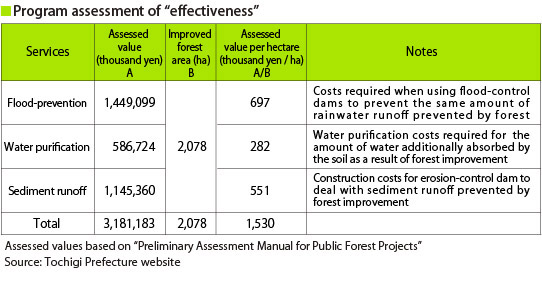
For forest improvement programs and soft projects for which valuations cannot easily be conducted, questionnaires are utilized. For example, the Satoyama Forest Improvement Program, which aims to preserve the landscape, guarantee safety and security in school zones and residential areas, and mitigate destructive intrusions by wild animals, conducts questionnaires to assess the program's effectiveness based on the ratio of respondents supportive of the program.
•References
· Assessment Committee for Tochigi Prefectural Tax for Health Forests (2009) Assessment Report
on Programs funded by the Tochigi Prefectural Tax for Health Forests
·Shimotsuke Shimbun, March 13, 2010, "Forest tax boosts felling in Tochigi forests: 6,100 ha in
2009, twofold increase in five years"
·Tochigi Prefecture (2006) Fourth Basic Greening Plan for Tochigi Prefecture: Tochigi Green Network
Plan
·Tochigi Prefecture (2009) Environmental White Paper of Tochigi Prefecture 2009
•Websites
· Healthy Forest-Making in Tochigi Prefecture
http://www.pref.tochigi.lg.jp/eco/shinrin/zenpan/genkinamoridukuri.html
· Tochigi Prefectural Tax for Healthy Forest-Making
http://www.pref.tochigi.lg.jp/eco/shinrin/zenpan/1216274969214.html
•Special thanks to
Tochigi Prefecture (Environment and Forest Policy Division)

